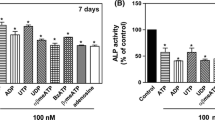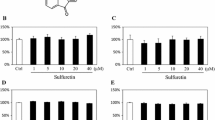Abstract
Recent studies indicate that the amount of alkaline phosphatase (ALP) activity in human osteoblast-line cells is proportional to the concentration of phosphate in the culture medium. The current studies were intended to extend those observations and to determine whether the effects of phosphate (and phosphate esters and analogs) to alter the cellular level of ALP activity, in human osteosarcoma SaOS-2 cells, reflected regulation at the level of transcription. Consistent with previous findings, we found direct, time- and dose-dependent correlations between the concentration of phosphate and the amount of ALP activity/mg cell protein (P<0.05). Surprisingly, we also found a negative correlation between the phosphate concentration in the medium and the level of skeletal ALP mRNA (e.g., r=-0.98, P<0.01 at 24 hours). As the highest cellular levels of skeletal ALP activity were associated with the lowest levels of ALP mRNA, these data indicated that the phosphate-dependent increase in ALP activity was not mediated by an increase in transcription and, conversely, that the effect of phosphate withdrawal to decrease ALP activity was not mediated by a decrease in transcription. Two additional studies have further suggested that these paradoxical effects of phosphate—increasing ALP activity while decreasing ALP mRNA—may be unique to inorganic phosphate: (1) β-glycerol-phosphate (at 10 mmol/liter) mimicked the action of phosphate to increase the cellular level of ALP activity (P<0.001), but did not mimick the action of phosphate to decrease the level of ALP mRNA; and (2) neither phenylphosphonate or molybdate (both of which, like phosphate, increased ALP activity, P<0.05) or borate (which decreased ALP activity, P<0.05) altered the level of ALP mRNA. In summary, these studies show that the effect of phosphate to regulate the level of ALP activity in human osteoblast-line cells is not determined by effects on ALP mRNA synthesis, suggesting that the regulation may depend on phosphate-dependent changes in the translation of ALP mRNA and/or a modification of ALP activity.
Similar content being viewed by others
References
McComb RB, Bowers GN Jr, Posen S (1979) Alkaline phosphatase. Plenum Press, New York
Harris H (1989) Alkaline phosphatase isozymes: What we know and what we don't know. Clin Chim Acta 186: 133–150
Gishman WH (1990) Alkaline phosphatase isozymes: recent progress. Clin Biochem 23: 90–104
Moss DW (1992) Perspectives in alkaline phosphatase research. Clin Chem 38: 2486–2492
Fallon MD, Whyte MP, Teitelbaum SL (1980) Stereospecific inhibition of alkaline phosphatase by L-tetramisole prevents in vitro cartilage calcification. Lab Invest 43: 489–494
Yoon K, Golub E, Rodan GA (1989) Alkaline phosphatase cDNA transfected cells promote calcium and phosphorous deposition. Connect Tissue Res 22: 17–25
Weiss MV, Cole DEC, Ray K, Whyte MP, Lafferty MA, Mulivor RA, Harris H (1988) A missense mutation in the human liver/bone/kidney alkaline phosphatase gene causing a lethal form of hypophosphatasia. Proc Natl Acad Sci USA 85: 7666–7669
Farley JR, Hall SL, Tanner MA, Wergedal JE (1994) Specific activity of skeletal alkaline phosphatase in human osteoblast-line cells regulated by phosphate, phosphate esters, and phosphate analogs and release of alkaline phosphatase activity inversely regulated by calcium. J Bone Miner Res 9: 497–508
Torriani A (1960) Influence of inorganic phosphate in the formation of phosphatases by Escherichia colii. Biochim Biophys Acta 38: 460–470
Lee KL, Aubin JE, Heersche JN (1992) β-Glycerolphosphate-induced mineralization of osteoid does not alter expression of extracellular matrix components in fetal rat calvarial cell culture. J Bone Miner Res 7: 1211–1219
Kyeyune-Nyombi E, Lau KH-W, Baylink DJ, Strong DD (1991) 1,25-Dihydroxy vitamin D3 stimulates both alkaline phosphatase gene transcription and mRNA stability in human bone cells. Arch Biochem Biophys 291: 316–325
Rodan SB, Imai Y, Thiede MA, Wesolowski G, Thompson D, Bar-Shavit Z, Shull S, Mann K, Rodan GA (1987) Characterization of a human osteosarcoma cell line (SaOS-2) with osteoblastic properties. Cancer Res 47: 4961–4966
Murray E, Provvendini D, Curran D, Catherwood B, Sussman H, Manolagas S (1987) Characterization of a human osteoblastic osteosarcoma cell line (SaOS-2) with high bone alkaline phosphatase activity. J Bone Miner Res 2: 231–238
Farley JR, Kyeyune-Nyombi E, Tarbaux NM, Hall SL, Strong DD (1989) Alkaline phosphatase activity from human osteosarcoma cell line SaOS-2: an isoenzyme standard for quantifying skeletal alkalin phosphatase activity in serum. Clin Chem 35: 223–229
Farley JR, Hall SL, Herring S, Tarbaux NM, Matsuyama T, Wergedal J (1991) Skeletal alkaline phosphatase specific activity is an index of the osteoblastic phenotype in subpopulations of the human osteosarcoma cell line SaOS-2. Metabolism 40: 664–671
Bradford MM (1976) A rapid and sensitive method for quantitation of microgram amounts of protein using the principle of protein-dye binding. Anal Biochem 72: 248–255
Weiss MJ, Henthorn PS, Lafferty MA, Slaughter C, Raducha M, Harris H (1986) Isolation and characterization of a cDNA encoding a human liver/bone/kidney-type alkaline phosphatase. Proc Natl Acad Sci USA 83: 7182–7186
Gunning P, Ponte P, Okayama H, Engel J, Blau H, Kedes L (1983) Isolation and characterization of full-length cDNA clones for human α-, β-, and γ-actin mRNAs: skeletal but not cytoplasmic actins have an amino-terminal cysteine that is subsequently removed. Mol Cell Biol 3: 787–795
Author information
Authors and Affiliations
Rights and permissions
About this article
Cite this article
Kyeyune-Nyombi, E., Nicolas, V., Strong, D.D. et al. Paradoxical effects of phosphate to directly regulate the level of skeletal alkaline phosphatase activity in human osteosarcoma (SaOS-2) cells and inversely regulate the level of skeletal alkaline phosphatase mRNA. Calcif Tissue Int 56, 154–159 (1995). https://doi.org/10.1007/BF00296348
Received:
Accepted:
Issue Date:
DOI: https://doi.org/10.1007/BF00296348




